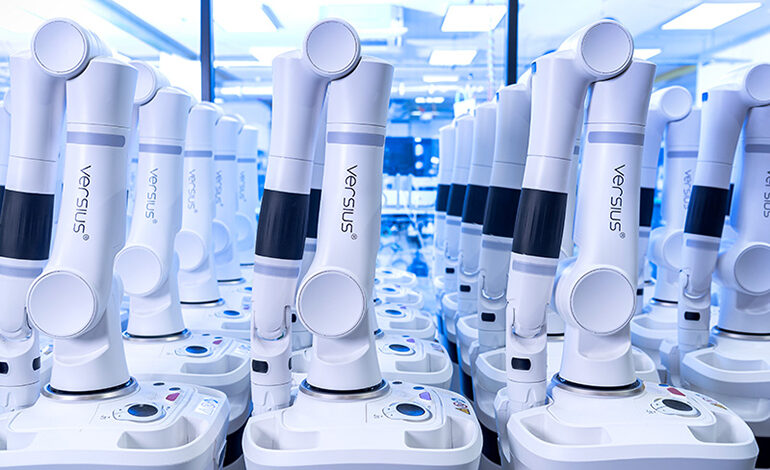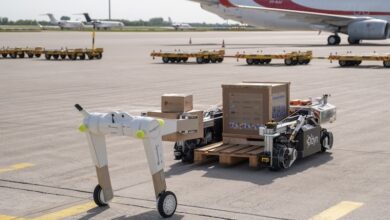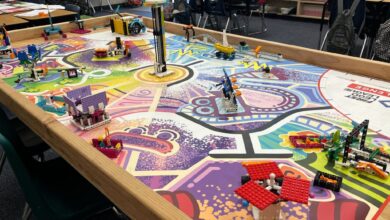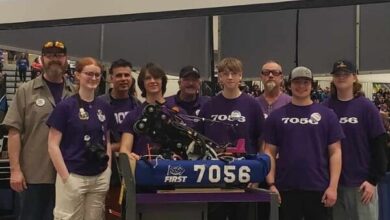Versius robot has ‘massive advantage’ for growth

CMR Surgical leaders say it’ll take the right kind of surgical robot to expand global adoption — and that their Versius system is just the thing.
CMR Surgical CEO Supratim Bose and co-founders Luke Hares (chief technology officer) and Dr. Mark Slack (chief medical officer) discussed what Slack called the “massive advantage” for Versius today in a keynote presentation at DeviceTalks Boston.
Bose expects continued growth in robotic surgery, and an accelerating rate if acceptance increase in emerging markets. But the question is how to get global penetration to tick up from about 10%, where it’s sat stubbornly for more than a decade.

“Long-term, that penetration has to increase,” he said. “It cannot remain at 10%. … A big part of the low penetration obviously was the overall cost of acquisition and trying to get the procedures to be affordable to patients. I think that we are addressing it better than most others.”
He also sees cause for optimism in governmental support of robotics in certain cases, as well as growth in the Versius system’s utilization rates, which he said is outpacing the rest of the market’s growth.
Related: 10 surgical robotics companies you need to know
The ‘massive advantage’ for CMR Surgical’s Versius

So why do CMR leaders believe their Versius system has what it takes to break the market open? It’s less about the surgical robotics market and more about minimal access surgery more broadly.
“Minimal access surgery is very, very difficult. If I wanted to teach you to tie a knot, it would take about 60 hours. If I want to teach on the robot, it will take about 40, 50 minutes,” Slack said. “Acquisition of skills, maintenance of skills, and higher surgical standards are all attainable with the correct robot. But it’s got to fit in the workflow, it’s got to be affordable, it’s got to be the right size, it’s got to be able to be packed away when you’re not using it.”
“The massive advantage of [Versius] is if you are not using it, we can stand it against the wall in the theater and the theater’s still totally usable,” Slack later continued. “The minute you want it, it’s wheeled across and you can put it in place, prep the patient, drape them and drape the arms of the robot in about 7 minutes. There’s no workflow interruption. It also provides the ability for a surgeon to do the entire procedure with the robot, or if they so choose they can do parts laparoscopically if they are a laparoscopic surgeon, and there may be areas where that may speed up things or genuinely help.”
It takes 10 to 14 cases with Versisus to get an expert laparoscopic surgeon to that same level using the system, which Slack called “extraordinary.”
“That’s not a guess — that’s measured and will be published. It just fits into your flow. You don’t have to alter your theater. You don’t have to adjust your lights. You don’t have to take the doors down to get it in and you don’t have the theater standing idle when it’s not being used,” Slack said.
Tapping the clinical potential of robotic surgery

But most exciting is the clinical potential of robotic surgery, Slack said, offering two examples. The first is reducing pain with the Versius robotic surgery system — and thus reducing opioid use.
“Because of the way Luke’s designed it, when the instrument goes through the abdomen, at the point it goes through it doesn’t exert any lateral pressure on the skin. That massively reduces pain control,” Slack said. “We have patients that virtually no longer need any form of opioid analgesia after a major laparoscopic operation because of the robot. Now in the U.S., 9% to 12% of patients who undergo surgery are still using opiates 12 months later, so something that avoids opiates is a real advantage.”
Another exciting clinical potential is to perform robotic procedures that can’t be done with manual laparoscopy.
“If you’ve got throat cancer, some of them they have to split your entire face to do the operation. And now with robotic surgery, it can be done through the mouth, therefore not disfiguring a person and getting an equivalent result,” Slack said. “I hope that within two or three years time, I will start producing the papers that show not just the equivalence, not just the increase in minimal access surgery, but the advantages of robotic surgery over laparoscopic surgery.”
Funding the mission
CMR Surgical has raised more than $1 billion, including a $600 million Series D round in 2021. But securing investments for surgical robotics “is a difficult sell,” Hares said.

“The challenge of a surgical robot is that the first amount of money it makes sense to raise — or at least it was 10 years ago or more now — is enough to build a system to prove your ideas work, and you’ve got it and there’s a lot of it to build, and it’s got to more or less work. That puts it sort of £5 million away and several years from getting started. But anyone who looks at the market and looks at the way the industry works will realize that that’s only the very, very beginning.”
“You’ve got to find people who have got the imagination to understand what you’re trying to achieve, and have also got the potential to be able to follow through for some very substantial later funding rounds,” he continued. “Because CMR wasn’t founded to invent a robot. CMR was founded to help millions of people have the right kind of surgery around the world. And to do that you’ve got to create a business that is building and selling and supporting and training ultimately thousands of robots globally, and that’s a massive organization. The diligence associated with that was quite considerable. I’m pleased to say we were able to convince people that it was indeed a feasible thing to be doing.”
Look for more coverage from this keynote and DeviceTalks Boston 2024 at MassDevice and Medical Design & Outsourcing in the days and weeks ahead.



